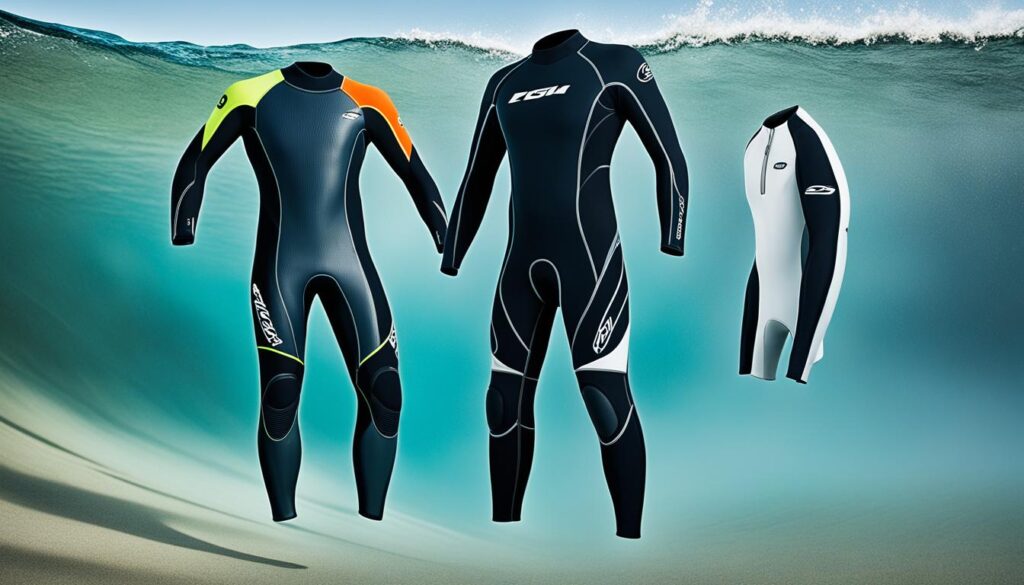When it comes to choosing a wetsuit for water activities, such as surfing or diving, one size does not fit all. Surfing wetsuits and diving wetsuits may look similar, but they are designed with distinct features to meet the specific needs of each activity. So, what exactly sets them apart? And how do you choose the right wetsuit for your aquatic adventures? Let’s dive in and explore the key differences between surfing and diving wetsuits.
Key Takeaways:
- Surfing wetsuits are thinner and more elastic to provide flexibility and freedom of movement on the surface of the water.
- Diving wetsuits are thicker and more insulated to withstand colder temperatures and prolonged exposure underwater.
- Surfing wetsuits often have additional features like knee and elbow pads for protection against the surfboard.
- Diving wetsuits are designed to handle the changes in pressure and the wear and tear from scuba gear.
- Choosing the right wetsuit involves considering factors like water temperature, fit, comfort, and additional features.
Characteristics of Surfing Wetsuits
Surfing wetsuits are specifically designed to meet the needs of surfers, providing them with the necessary warmth and flexibility while riding the waves. These wetsuits differ from diving wetsuits in several key aspects, making them tailored for the unique demands of surfing.
One notable difference is the thickness of the wetsuits. Surfing wetsuits are typically thinner than diving wetsuits as surfers spend most of their time on the surface of the water rather than being fully immersed. The thinner material allows for greater freedom of movement, enabling surfers to paddle and maneuver with ease.
Another essential feature of surfing wetsuits is their high elasticity. The material used in these wetsuits has a remarkable level of stretch, providing surfers with the flexibility they need to perform their maneuvers comfortably. This elasticity allows surfers to bend, twist, and turn their bodies effortlessly, enhancing their overall performance in the water.
In addition to their thinness and elasticity, surfing wetsuits often come equipped with additional features that further enhance the surfer’s experience. Reflecting the rigorous movement involved in surfing, these wetsuits may include reinforced knee and elbow pads to provide extra protection and durability. Furthermore, many surfing wetsuits feature a rubber layer over the chest area, protecting it from potential damage caused by contact with the surfboard during paddling.
When choosing a surfing wetsuit, it’s important to consider these features to ensure a comfortable and optimal surfing experience. The right wetsuit will provide the necessary warmth, flexibility, and protection, allowing surfers to fully enjoy their time in the water.
Characteristics of Diving Wetsuits
Diving wetsuits are specifically designed to meet the unique demands of divers, offering essential features that ensure insulation, pressure resistance, and durability in underwater environments. These wetsuits are tailored to provide maximum comfort and protection during longer periods of submersion in colder waters.
Insulation: Diving wetsuits are thicker compared to surfing wetsuits, providing superior insulation against the cold temperatures experienced below the water’s surface. The increased thickness of these wetsuits traps a layer of water between the body and the suit, which then gets heated by body temperature to create a thermal barrier.
Pressure Resistance: Diving wetsuits are engineered to withstand the changes in pressure that occur with depth. Unlike surfing wetsuits, which compress more readily, diving wetsuits maintain their integrity and ensure a comfortable fit even as divers descend to greater depths.
Durability: The material used in diving wetsuits is denser and sturdier, offering enhanced durability to withstand the wear and tear caused by scuba gear, rocks, and underwater obstructions.
Types of Diving Wetsuits
| Wetsuit Type | Description |
|---|---|
| Full Wetsuit | Covers the entire body and provides maximum insulation and protection |
| Shorty Wetsuit | Covers the torso and upper thighs, suitable for warmer waters or for added mobility |
| Dry Suit | Designed for extreme cold-water diving, keeps the diver completely dry and requires specialized training |
| Semi-Dry Suit | Offers increased protection against water ingress, while maintaining flexibility and ease of movement |
Diving wetsuits are available in various styles and designs, allowing divers to choose the right wetsuit based on their specific needs and preferences. From full suits for maximum insulation to shorty and semi-dry suits for warmer waters or improved mobility, there is a diving wetsuit to suit every diving condition.
With their insulation, pressure resistance, and durability, diving wetsuits provide the necessary comfort and protection for divers exploring the depths of the ocean. Choosing a diving wetsuit tailored to your diving requirements is essential to ensure a safe and enjoyable underwater experience.
Why Surfing Wetsuits are not Suitable for Diving
When it comes to choosing the right wetsuit for your aquatic adventures, it’s crucial to select one that is specifically designed for the activity you’ll be participating in. While surfing and diving wetsuits may appear similar, they have distinct differences that make them suitable for their respective sports. Using a surfing wetsuit for diving is not recommended due to several limitations.
Limitations of Surfing Wetsuits for Diving
Surfing wetsuits are designed with the needs of surfers in mind and may not provide adequate protection and functionality for diving activities. Here are the key limitations of using surfing wetsuits for diving:
- Thermal Protection: Surfing wetsuits are typically thinner compared to diving wetsuits as surfers are more active on the water surface than submerged. This reduced thickness does not provide sufficient thermal insulation required for prolonged periods of diving in colder waters.
- Pressure Resistance: Diving involves descending to various depths, where the pressure on the body increases significantly. Surfing wetsuits are not designed to handle these changes in pressure and may compress, compromising the wetsuit’s effectiveness.
- Durability: Diving gear, such as scuba tanks and weight belts, can cause wear and tear on a wetsuit. Surfing wetsuits are not built to withstand this additional stress and may not be as durable as diving wetsuits.
| Limitations of Surfing Wetsuits | Diving Requirement |
|---|---|
| Thin Material | Thermal Protection |
| Lack of Pressure Resistance | Pressure Handling |
| Not Designed for Scuba Gear | Durability |
“Surfing wetsuits are optimized for warmth and flexibility in surf conditions, not for the thermal protection, pressure resistance, and durability required for diving.” – Wetsuit Expert
Therefore, it is crucial to invest in a diving wetsuit that is specifically designed to meet the demands of the sport. Diving wetsuits offer enhanced thermal protection, pressure resistance, and durability to ensure maximum comfort and safety in underwater environments.
Image: A diver wearing a diving wetsuit showcasing the superior thermal protection and durability compared to a surfing wetsuit.
Why Diving Wetsuits are not Suitable for Surfing
While diving wetsuits are well-suited for underwater exploration, they are not the ideal choice for surfing. The unique demands of surfing require a wetsuit specifically designed for the sport, and diving wetsuits may fall short in meeting these requirements.
The primary limitation of using a diving wetsuit for surfing is the thicker and denser material. Diving wetsuits are designed to withstand the pressure and cold temperatures underwater, which means they tend to be bulkier and less flexible than surfing wetsuits. This can restrict movement and hinder the surfer’s ability to paddle efficiently and maneuver on the waves.
Moreover, the thicker material of diving wetsuits can trap and retain heat, leading to overheating and discomfort while out on the waves. Surfers need a wetsuit that allows for proper ventilation and breathability to regulate body temperature during active sessions.
Another factor to consider is durability. Diving wetsuits are built to withstand the wear and tear associated with scuba diving equipment, such as BCDs and weight belts. While this durability is beneficial for underwater activities, it can be excessive for surfing, where the wetsuit may come into contact with the surfboard and incur unnecessary friction. Surfing wetsuits, on the other hand, often feature knee and elbow pads to provide extra protection against board-related impact.
Ultimately, when it comes to selecting the right wetsuit for surfing, it’s crucial to choose one that is specifically designed to cater to the unique needs of the sport. Investing in a quality surfing wetsuit will enhance mobility, provide proper insulation, and ensure a comfortable and enjoyable surfing experience.
Diving Wetsuits vs. Surfing Wetsuits: A Comparison
| Characteristic | Diving Wetsuits | Surfing Wetsuits |
|---|---|---|
| Thickness | Thicker material for insulation | Thinner material for flexibility |
| Movement | Restricted movement due to thicker material | Greater freedom of movement |
| Heat Retention | Retains heat for cold-water environments | Allows for proper ventilation and breathability |
| Durability | Built to withstand scuba diving equipment | Features additional protection, such as knee and elbow pads |
Choosing the Right Wetsuit for Your Activity
When it comes to choosing a wetsuit, several factors should be considered to ensure you find the perfect fit for your water activities. Whether you’re a surfer or a diver, finding the right wetsuit is crucial for maximum comfort and performance in the water.
Factors to Consider When Choosing a Wetsuit:
- Water Temperature: The water temperature is a key factor in determining the thickness of your wetsuit. Cold water requires a thicker wetsuit for better insulation, while warm water may call for a thinner wetsuit for greater flexibility.
- Additional Features: Consider the additional features you may need in a wetsuit. Features like seals and zips can provide added protection against water entry and enhance the wetsuit’s performance. Look for reinforced knees and elbows for increased durability.
- Fit and Comfort: A proper fit is essential for a wetsuit to function effectively. It should fit snugly but not too tight so that it restricts movement. Opt for a wetsuit that allows for easy mobility and flexibility while providing a comfortable fit.
- Women’s Wetsuits: Women should choose wetsuits designed specifically for the female form. These wetsuits are tailored to provide a better fit and enhanced comfort for women.
When purchasing a wetsuit, it’s recommended to visit a local surf shop or a PADI Dive Center. Trying on different wetsuits allows you to test the fit and determine which style and brand best suit your needs. Remember that a wetsuit should prevent water from flowing in and out while still providing comfort and ease of movement in the water.
Now that you have a better understanding of the key factors to consider, you can confidently choose the right wetsuit for your water activities, ensuring an enjoyable and comfortable experience in the ocean.
The Importance of Trying on Wetsuits
When it comes to finding the perfect wetsuit, there’s no substitute for trying them on in person. While online shopping offers convenience, the fit of a wetsuit is crucial for comfort, performance, and safety in the water. Here are the reasons why trying on wetsuits is so important:
1. Ensuring the Right Fit
The fit of a wetsuit is essential for its functionality. Wetsuits should be tight-fitting to prevent water from entering, but not so tight that they restrict movement or breathing. Trying on different sizes and styles allows you to find the wetsuit that provides a snug and comfortable fit, ensuring optimal mobility in the water.
2. Comparing Styles and Manufacturers
Visiting a physical store gives you the opportunity to compare wetsuits from various manufacturers and try on different styles. Each brand may have slight variations in sizing, features, and materials. By trying on a range of options, you can determine which brand and style best suits your needs and preferences.

3. Expert Advice and Guidance
“Shop staff can provide valuable expertise and guidance when choosing a wetsuit. They have extensive knowledge about the different brands and styles available and can steer you towards the best options based on your preferences and intended water activities.”
4. Understanding Additional Features
Trying on wetsuits in person allows you to explore and understand the additional features that a wetsuit may offer. These can include reinforced knees and elbows, built-in hoods, or specialized linings for added warmth and durability. Experiencing these features firsthand helps in making an informed decision about which ones are most important to you.
In conclusion, trying on wetsuits in-store provides you with the opportunity to find the perfect fit, compare styles and manufacturers, benefit from expert advice, and fully understand the additional features available. Investing the time to try on wetsuits ensures that you choose a wetsuit that not only performs well but also provides the comfort and support you need for your water adventures.
Considerations for Divers
Diving wetsuits come with several features that cater to the specific needs of divers. These features enhance comfort, thermal protection, and gear compatibility, ensuring a safe and enjoyable diving experience.
Zips on Diving Wetsuits
Diving wetsuits often feature zips on the ankles and wrists, allowing for easier donning and doffing. The added convenience of these zips saves time and effort, especially when getting in and out of the wetsuit quickly is essential.
Rubber Seals for Thermal Protection
When choosing a diving wetsuit, consider one with rubber seals at the wrists, ankles, and neck. These seals provide enhanced thermal protection by minimizing water exchange and increasing insulation. Rubber seals help to keep you warm in colder water temperatures, ensuring a comfortable dive.
White Belts and Gear Compatibility
Gear compatibility is crucial for divers to ensure that their equipment works seamlessly together. Many diving wetsuits feature white belts that allow divers to attach weight belts securely. This design feature ensures gear compatibility and provides an optimal diving experience.
Women’s Diving Wetsuits
Female divers should opt for women’s diving wetsuits specifically designed to provide a better fit and comfort for their body shapes. These wetsuits take into account the unique requirements of female divers, offering a more tailored and comfortable diving experience.
When selecting a diving wetsuit, keep these considerations in mind to find the right suit that meets your needs and enhances your diving adventures.
Personal Preference in Wetsuit Selection
When it comes to choosing a wetsuit, personal preference plays a significant role. Different individuals have varying preferences when it comes to brands, thickness, stitching, and zipper styles. Some may prefer renowned brands known for their quality and durability, while others may prioritize affordability without compromising on performance.
Another aspect to consider is the thickness of the wetsuit. Thicker suits provide more insulation and are ideal for colder water conditions, while thinner suits offer greater flexibility and are preferable in warmer waters.
Stitching preferences are also an important consideration. Flatlock stitching is common in wetsuits and allows for flexibility, while glued and blind-stitched seams provide enhanced durability and protect against water ingress for a more comfortable experience.
Furthermore, the choice of zipper style can impact the ease of donning and doffing the wetsuit. While back zippers are common and easy to maneuver, chest zippers provide a more secure fit and minimize water entry.
Given that conditions can vary and individuals may travel to different locations, having multiple suits for different conditions might be necessary. This allows you to adapt to different water temperatures and stay comfortable during your aquatic adventures.
In conclusion, finding the right wetsuit that suits your personal preferences is essential for an enjoyable experience. Consider factors like brand, thickness, stitching, zipper style, and the need for multiple suits based on changing conditions. Don’t hesitate to try on various wetsuits to find the perfect fit and make the most of your time in the water.

